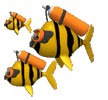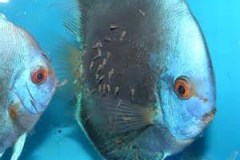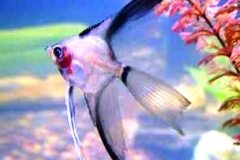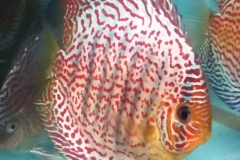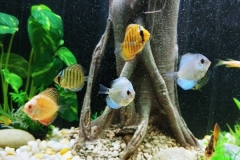Feeding Discus Fish a high-quality, protein-rich diet is essential for their health, growth, and vibrant coloration. Beef Heart Flakes from www.somethingsphishy.com provide a convenient, nutritionally dense option that addresses these needs effectively. Beef Heart is exceptionally high in quality protein (over 45%) and all essential amino acids, which are crucial for the development of healthy, robust Discus, especially juveniles. This high protein content is a primary reason breeders have long favored Beef Heart in their feeding regimens. Beef Heart Flakes from Somethingsphishy are fortified with Vitamins and Minerals to ensure a balanced diet. One last important quality of our Beef Heart Flake is they do not foul or color the water as ground raw Beef Heart and many other Flakes are prone to do. You can buy our Beef Heart Flake at this Link: SomethingsPhishy Fish Food. We recommed you feed your Discus three times daily and Beef Heart Flake should be used for at least one of those feeding. You can find it on the same page with all of our Discus Fish for Sale.
Category Archives: Uncategorized
Growing Out Discus Fry – Short Summary
- From Brine Shrimp to Solid Foods: Continue feeding live baby brine shrimp for a few more weeks as they are an excellent, high-protein food source. Gradually introduce finely crushed, high-quality flake food or a specialized commercial discus granular food.
- Frequency: Feed small amounts frequently—ideally 5 to 6 times per day. Young discus have high metabolisms and require constant nutrition to grow quickly.
- Variety: Introduce variety with a quality frozen mix (like a beef heart blend, mysis shrimp, or bloodworms) finely minced. A varied diet ensures they receive all necessary nutrients.
- Daily Water Changes are Crucial: You correctly noted the sensitivity of young fry to ammonia. As they grow and eat more, they produce significantly more waste. Daily partial water changes (50% or more) are mandatory. Strive for water parameters as close to ideal as possible.
- Temperature Control: While they are hardier now, maintaining stable water temperature (around 82°F to 86°F or 28°C to 30°C) is essential. Continue to ensure that any replacement water is exactly the same temperature as the tank water to prevent shock.
- Filtration Upgrade: The gentle sponge filter used for the tiny fry can now be supplemented or replaced. Once the babies are clearly strong swimmers and growing, you can introduce a gentle hang-on-back filter or a canister filter, provided the intake is covered with a sponge to protect any smaller or weaker fish.
Discus Bullying
Bullying by Discus amongst each other is very common and should be expected and planned around.
Discus bully other Discus for mainly one reason, to establish a pecking order. It can take months to establish a pecking order, but once it is established the bullying usually lessens. The most aggressive bullying usually happens amongst larger Discus that are close in size and age. It is not always the largest that wins the top of the pecking order. Sometimes a Discus that is slightly smaller is just more aggressive and can be above another Discus that is slightly bigger. It is not always the males that are on the top. I have had many times had the female being bigger bullies that similar sized males.
The only other reason for bullying is when to have pair are spawning or are preparing to spawn. The pair will almost always chase all of the other Discus to the other end of the tank and will be relentless. The male will be the most aggressive. The upside is that Discus will have their best coloration that they will ever have during the spawning.
The good news is that Discus almost never bully another Discus to the point that it kills the Discus being bullied. With that said, it can be hard watch is not wanted in the aquarium.
There is nothing you can do to stop the bullying. There are some tricks that do work to lessen it. Distractions are the main tool to lessen bullying. I have found the most effective way to reduce bullying is to have large schools of very brightly colored fish in the tank. My main go to is Neon Tetras. Adding several bubblers will also create distractions.
Hiding places are another necessary tool. Large rock formation, driftwood and/ or heavily plants tanks will supply the necessary hiding spots to allow one Discus to get away from another bullying Discus.
When there is a bully in the tank it is important to feed your Discus at both ends of the tank at the same time and to have at least one of the feedings at night with the lights off. That will help insure that all of the fish have access to food.
See all the Discus Fish for Sale at www.SOMETHINGSPHISHY.com
Please Visit our New Instagram Page at Somethingsphishy Instagram
German Blue Ram Care and Breeding Instructions
The German Blue Ram is a beautiful but sensitive freshwater tropical fish requiring warm water, proper and appropriate diet and peaceful tank mates for best health and longevity. They are great tankmates for Discus Fish and Angelfish. They come from the same rivers in the Amazon Basin as do Discus Fish and Angelfish.
Tank Setup and Water Parameters
- Tank Size: Minimum of 20 gallons for a pair or trio to ensure ample swimming space and reduce territorial stress .
- Temperature: Maintain between 78°F and 86°F (25°C to 29°C). Stable warmth is crucial as sudden drops harm them .
- pH: Ideally 6.0 to 7.5, often slightly acidic (6.0-6.5) mimicking their native slow-moving, tannin-rich South American waters .
- Water Hardness: Soft to moderately hard water, with a TDS under 250.
- Filtration & Flow: Use gentle filtration with slow water flow since they come from calm waters; biological filtration is essential to maintain pristine water quality .
- Substrate: Medium or soft substrate is recommended as they sift the substrate for food . Avoid sharp gravel that can injure them.
- Important: Avoid over-crowding the tank.
Diet and Feeding
- German Blue Rams are omnivores: feed a varied diet including high-quality sinking pellets or flakes designed to provide a variety of animal and plants nutrition.
- Freeze Dried Bloodworms, Tubifex, , Brine Shrimp (live, frozen and freeze dried) and Daphnia.
- Feed 2-3 small meals per day, only as much as they consume in 10 minutes to avoid overfeeding and maintain water quality.
- They can be picky when first introduced, so frozen/live food often encourages feeding.
Behavior and Tank Mates
- German Blue Rams are generally peaceful but can territorial among themselves, especially during breeding.
- They thrive in community tanks with other small, peaceful fish that share similar water requirements, including various tetras (Neon, Cardinal, Rummy-Nose), Corydoras catfish, smaller Gouramis, and Plecos. They also do great with Discus Fish and Angelfish.
- Avoid aggressive or large fish that may bully or prey on them (e.g., Oscars, Jack Dempsey, African Cichlids). An exception would be that they generally do well with Severums and Parrot Fish.
- Provide hiding places and visual barriers to reduce stress and aggression.
- Pairs or small groups are recommended, keeping males separated in larger tanks to reduce conflict. We recommend at least 5.
Breeding German Blue Rams
- Pairs form naturally; breeding in captivity is relatively easy but requires stable, slightly warmer water (82-86°F) and soft, slightly acidic water to stimulate pairing of and spawning.
- Provide flat rocks or broad leaves as spawning sites.
- Eggs hatch in about 48-72 hours; parental care is strong, but early spawns may be eaten.
- Raise fry with fine foods like Infusoria, Microworms, and later baby Brine Shrimp.
- Separate breeding tank (10-20 gallons) with gentle sponge filtration and minimal stress is advised for best success.
Discus Fish Growth Rates
Discus fish growth rates are influenced by many different factors. The main factor is keeping them healthy in a very clean aquarium. If any of your fish get sick at all the growth will stop until they get healthy again. Growth will also slow down or stop if they are stressed out from an aquarium with non-optimal water conditions. Choosing a high protein diet that the fish will happily eat is important. The higher the protein content, the faster the growth. The size of the aquarium is very important. I would recommend a minimum size of 55 gallons. Discus kept in an undersized or overcrowded tank will slow significantly in growth rates and will never get to the normal mature size. We have found that creating some current in the tank will also slightly increase the growth rate. In an ideal setting, discus fish can be expected to grow about 4 inches in a year. At fish farms with outside large ponds, they can grow to 5-6 inches in one year.
Please see all of the Discus fish for Sale at www.SOMETHINGSPHISHY.com
Origins of Pigeon Blood Discus
Historical Background
Today, the Pigeon Blood Discus is widely available, with many variations and refinements resulting from ongoing breeding efforts. This strain has become foundational in the continued development of new discus colors, making it a significant feature in the aquarium hobby. Its unique genetic traits contributed to expanding the color spectrum and types of discus fish enjoyed by aquarists worldwide.
Naming Origin
The name “Pigeon Blood” is derived from the deep red coloration of its eyes. Additionally, it is said that the term has historical roots in old Asian slang; “pigeon blood” referred to a reddish pigment, and the freckles (peppering) on the fish’s body gave the illusion of being splattered with this color
Breeding and Characteristics
Upon introduction, the Pigeon Blood Discus faced skepticism, with early specimens accused of being overly hormone-infused during competitions. However, despite this initial controversy, their striking appearance quickly gained popularity within the aquarium hobby. These fish are now recognized for their vibrant coloration and unique traits, such as a lack of vertical stress bars and beautiful peppering against a pale base color.
Over time, selective breeding has resulted in cleaner forms of Pigeon Blood Discus, with reduced black spots and enhanced coloration
Current Availability and Impact
Today, the Pigeon Blood Discus is widely available, with many variations and refinements resulting from ongoing breeding efforts. This strain has become foundational in the continued development of new discus colors, making it a significant feature in the aquarium hobby. Its unique genetic traits contributed to expanding the color spectrum and types of discus fish enjoyed by aquarists worldwide.
See all the Discus Fish for Sale at www.SOMETHINGSPHISHY.com
A Brief History of Discus Fish
Throughout the 20th century, Discus fish gained popularity among aquarium enthusiasts. They became even more popular after successful breeding ventures began in the 1930s. Initially, attempts to bring them to Europe faced high mortality rates due to stressful transport conditions. It wasn’t until improved shipping methods were adopted in the 1950s that Discus Fish began to thrive in captivity. Breeders like Eduard Schmidt-Focke made pivotal strides in captive breeding. The 1960s and 70s marked a significant era of breeding innovations. That resulted in colorful varieties such as Blue Diamond Discus Fish. Hybrids like the Pigeon Blood led to a larger expansion of colors and patterns.
Today, Discus Fish hold the status of “King of the Aquarium,” boasting a range of colors and patterns that are the result of modern selective breeding.
Wild Discus Fish are primarily found in the Amazon River and its tributaries, where they inhabit areas with low mineral content and slightly acidic waters. Replicating their natural habitat in an aquarium setting is crucial for their health; therefore, Discus Fish remain one of the more challenging yet rewarding fish species for aquarists. Their history reflects not only their biological significance but also their cultural impact, as they have become symbols of beauty and exoticism in freshwater aquariums across the globe.
In summary, the journey of Discus Fish from being discovered in the wild to becoming a centerpiece of aquarium displays.
See all the Discus Fish for Sale at www.SOMETHINGSPHISHY.com
Breeding Flowerhorn cichlids
Making your Flowerhorn cichlids breed in the aquarium requires basically the same type of preparations and care that you would give Trimac cichlids or other similar South American cichlids. Keep the potential parents in a very large aquarium, and try to keep them from killing each other. Flowerhorn parents guard the eggs as well as the fry, and the fry is fairly easy to take care off. Even if you start out with prime specimens as parents, the offspring will often turn out to be a disappointment if it is certain color patterns etcetera that you are looking for. You need to know quite a lot about the different strains and lines to successfully breed Flowerhorn cichlids. There is of course always the chance of getting lucky and producing great specimens even without this knowledge.
How to care for a Flowerhorn cichlid
The Flowerhorn cichlid is considered quite easy to take care of and do not require a lot of pampering from its keeper. The first thing you need to do is of course to set up an aquarium suitable for a Flowerhorn cichlid. Your Flowerhorn will require a large aquarium to do well, since this fish grows quite big and have an aggressive temperament. If you use plants to decorate the aquarium, they might be destroyed by the Flowerhorn cichlid, and plants are not necessary in an aquarium set up for a Flowerhorn cichlid. You should however decorate the aquarium in a way that creates natural territorial borders, since the Flowerhorn cichlid is a territorial and aggressive fish. You can of course keep the Flowerhorn cichlid alone, but if you want to have more than one fish in the aquarium other big aggressive cichlids from South America is the best choice. The Flowerhorn cichlid is a tough fish and can tolerate most water conditions, but it will do best in an aquarium where the pH is neutral or slightly basic. A water temperature around 28º C is recommended.
The Flowerhorn cichlid is a happy eater and you will not have a hard time trying to make it accept food. Its metabolism and feeding habits are similar to that of the other South American cichlids, and your Flowerhorn cichlid will need a lot of energy and nutrients to stay healthy and develop in a good way. It is actually quite hard to over-feed a Flowerhorn cichlid. Your Flowerhorn cichlid will accept most types of food, and pellets are a good base. This base should be supplemented with plenty of worms, crabs, shrimp, or similar types of meaty foods. Feeding two or tree times a day is optimal.
Since the Flowerhorn cichlid eats a lot, it will also produce a lot of waste products which pollutes the water. Frequent water changes must therefore be performed. Changing 20 percent of the water twice a week is a good rule of thumb. If you can only make one change a week, you should change around 25 percent of the water. You can lower the risk of poor water quality by avoiding food types known to pollute the water a lot.
The history of the Flowerhorn cichlid
The Flowerhorn cichlid is a result of hybrid between different South American cichlids. The Flowerhorn was developed in Malaysia during the second half of the 1990s, and exactly which South American cichlids that was used and in which combinations is still a secret. This secrecy has of caused a lot of speculation and a number of more or less reasonable theories have been put forth. One of the more far-fetched theories suggests that the Flowerhorn cichlid was artificially created in a Malaysian genetics laboratory by combining genes from a Goldfish with genes from the Trimac cichlid (Amhilophous Trimaculatus). A more reasonable suggestion is that the Flowerhorn cichlid is the result of crossing many different types of South American cichlids with each other, and that different forms of Flowerhorn cichlids can steam from different South American cichlids. The most plausible ancestry is crossings between the Trimac cichlid and other South American cichlids such as Midas cichlid (Amphilophus citrinellum), Red Devil cichlid (Amphilophus labiatum) and Redheaded cichlid (Vieja synspila).
The look of the Flowerhorn cichlids available in fish stores today is however not just the result of selective breeding. You can affect the appearance of a Flowerhorn cichlid by adjusting environmental factors such as the water chemistry in the aquarium. The food you feed your Flowerhorn cichlid can also change its look. The single most important factor behind the look of the fish is however the genetic makeup formed by selective breeding.
The Flowerhorn has been criticized as an unnatural and dangerous hybrid, produced by money-hungry breeders just to make money. Others have been impressed by the hard work that is evidently behind the creation of the Flowerhorn Cichlid. A lot of the South American cichlids mentioned above will occasionally interbreed in the wild as well, but there is no doubt that the Flowerhorn cichlid has been deliberately produced by breeders. The Flowerhorn cichlids are not the result of random cross breeding. Some people view the Flowerhorn as a purely man-made creation while others compare the hybrid to all the other animal variants that have been refined by humans during centuries of selective breeding.
